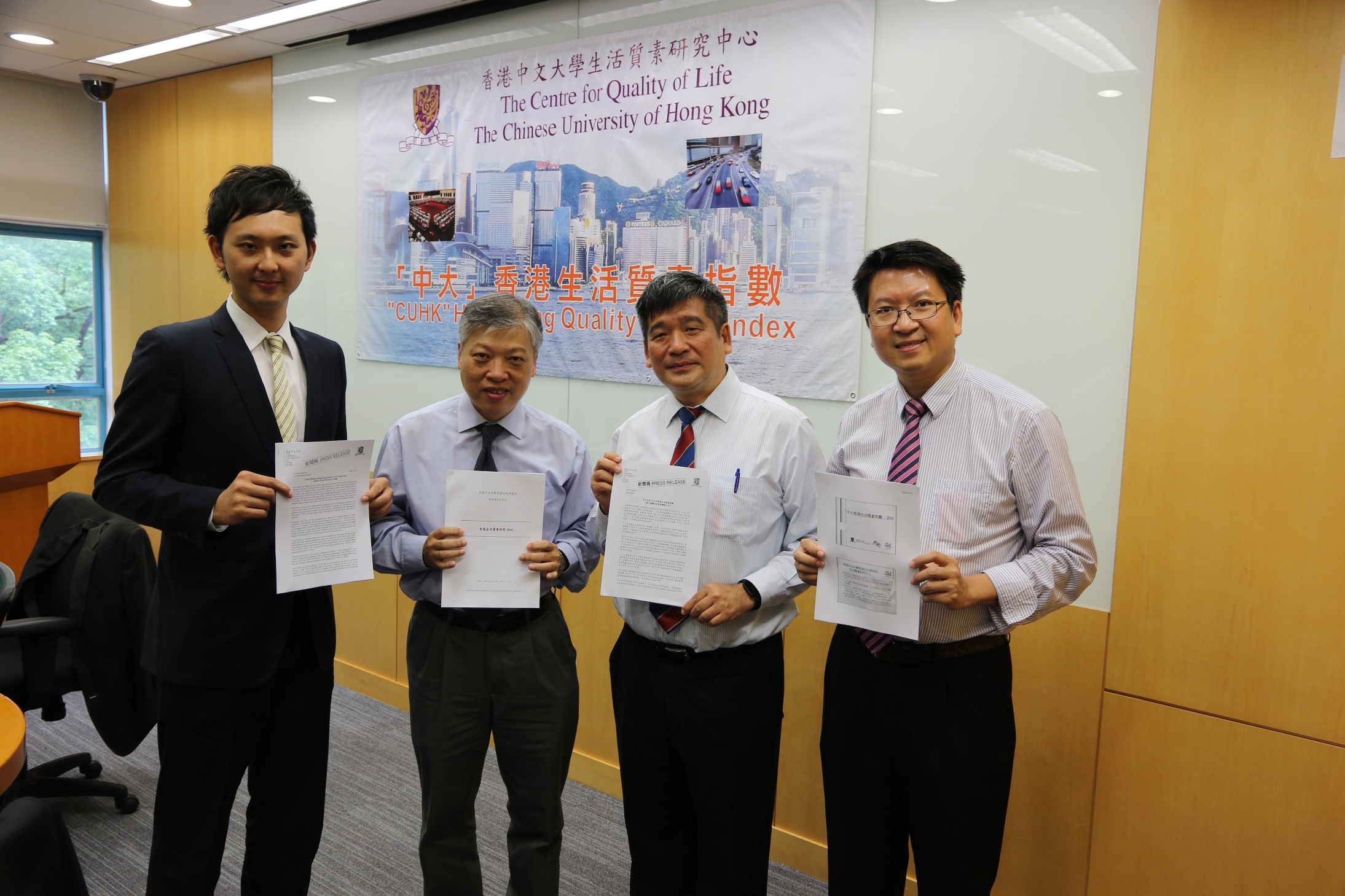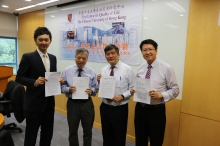CUHK
News Centre
CUHK Releases Hong Kong Quality of Life Index 2016Quality of Life Improves Visibly
The Centre for Quality of Life of the Hong Kong Institute of Asia-Pacific Studies at The Chinese University of Hong Kong (CUHK) released the ‘CUHK Hong Kong Quality of Life Index’ 2016 today (6 July). According to the latest ‘CUHK Hong Kong Quality of Life Index’ (the Index), the overall score in 2016 was 105.39, an increase of 4.07 points from the score in 2015 (101.32). The result indicated that the quality of life in Hong Kong generally improved in the past year, which is also an increase for the first time since 2010 (Appendix 1). The Economic sub-index has increased for the first time in ten years; the Health, Social, Culture and Leisure, and Environmental sub-indices increased as well.
The Index consists of 23 indicators that are grouped into five sub-indices: Health, Social, Culture and Leisure, Economic, and Environmental (Appendix 2). The indicators are selected according to the coverage, representativeness, measurability, and importance to the quality of life of Hong Kong people. The higher the indicator scores, the better it performs.
Compared with 2015, all five sub-indices have improved in different degrees in 2016 (Appendix 3). Particularly, the Economic sub-index went up to 14.51 with a significant increase of 1.95 points. The Social sub-index increased 0.76 points to 27.67, second only to the highest point in 2009 (27.90). The Environmental sub-index increased 0.62 points to 21.6 while the Culture and Leisure sub-index increased 0.49 points to 17.45. The Health sub-index slightly increased 0.25 points to 24.16. The result shows that the five aspects of the quality of life in Hong Kong improved in the past year.
19 out of the 23 indicators improved in 2016 (Appendix 4). A noticeable increase in real rental index and housing affordability ratio were observed, with 18.89% and 17.46% increased between 2015 and 2016, respectively. The overall crime rate, real wage index, overseas travel index and air index also improved significantly, with an increase ranged from 6.37% to 7.82%. The increase of the remaining indicators was relatively mild, ranging from 0.19% to 4.97%.
Compared with 2015, 4 out of the 23 indicators worsened in 2016 (Appendix 5). The cultural programmes attendance index decreased significantly, with 8.97% decline between 2015 and 2016. The decrease of freedom of speech index, average patient days and press criticism index was relatively mild, ranging from 0.99% to 2.69%.
The ‘CUHK Hong Kong Quality of Life Index’ was designed by the Faculty of Social Science in 2003. This composite index is intended to measure and keep track of the quality of life in Hong Kong in the 21st century, and to provide policy makers and the community with a useful reference tool. It also aims at raising the awareness of enhancing the quality of life of Hong Kong people. To continue this mission, in 2006, the Centre for Quality of Life was set up by the Hong Kong Institute of Asia-Pacific Studies, CUHK to conduct on-going quality of life research and release the latest Index annually. Since 2012, the Centre for Quality of Life of the Hong Kong Institute of Asia-Pacific Studies has also compiled the ‘MTR-CUHK Youth Quality of Life Index’. The results of these two indices can be used for comparison and cross-reference.
2002 was the base year of the ‘CUHK Hong Kong Quality of Life Index’, and the value of the Index for that year was set at 100. If the value of the Index of a subsequent year is above 100, it means that the quality of life in Hong Kong in that year is better than that of 2002. If the value of the Index is below 100, it reveals that the quality of life in Hong Kong in that year is worse than that of 2002. If the value of Index is 100, it indicates that the quality of life in Hong Kong in that year is the same as that of 2002.
In order to measure and monitor more aspects of the quality of life in Hong Kong, based on the stage of social development, the research team of the Centre of Quality of Life of the Hong Kong Institute of Asia-Pacific Studies will refine the composition and calculation methodology of the Index from time to time. From last year onwards, the number of sub-indices of the ‘CUHK Hong Kong Quality of Life Index’ has been increased from three to five, namely, Health, Social, Culture and Leisure, Economic and Environmental sub-indices. The number of indicators included in the Index has been increased from 21 to 23.
For more information on the ‘CUHK Hong Kong Quality of Life Index,’ please visit the website of the Centre for Quality of Life, Hong Kong Institute of Asia-Pacific Studies, CUHK: www.cuhk.edu.hk/hkiaps/qol.
(From right) Prof. Chong Tai-leung Terence, Associate Professor, Department of Economics; Prof. Wong Hung, Director, Centre for Quality of Life, Hong Kong Institute of Asia-Pacific Studies, and Associate Professor, Department of Social Work; Prof. Ting Kwok-fai, Professor, Department of Sociology; and Prof. Chung Yat-nork Roger, Assistant Professor, JC School of Public Health and Primary Care, CUHK.





